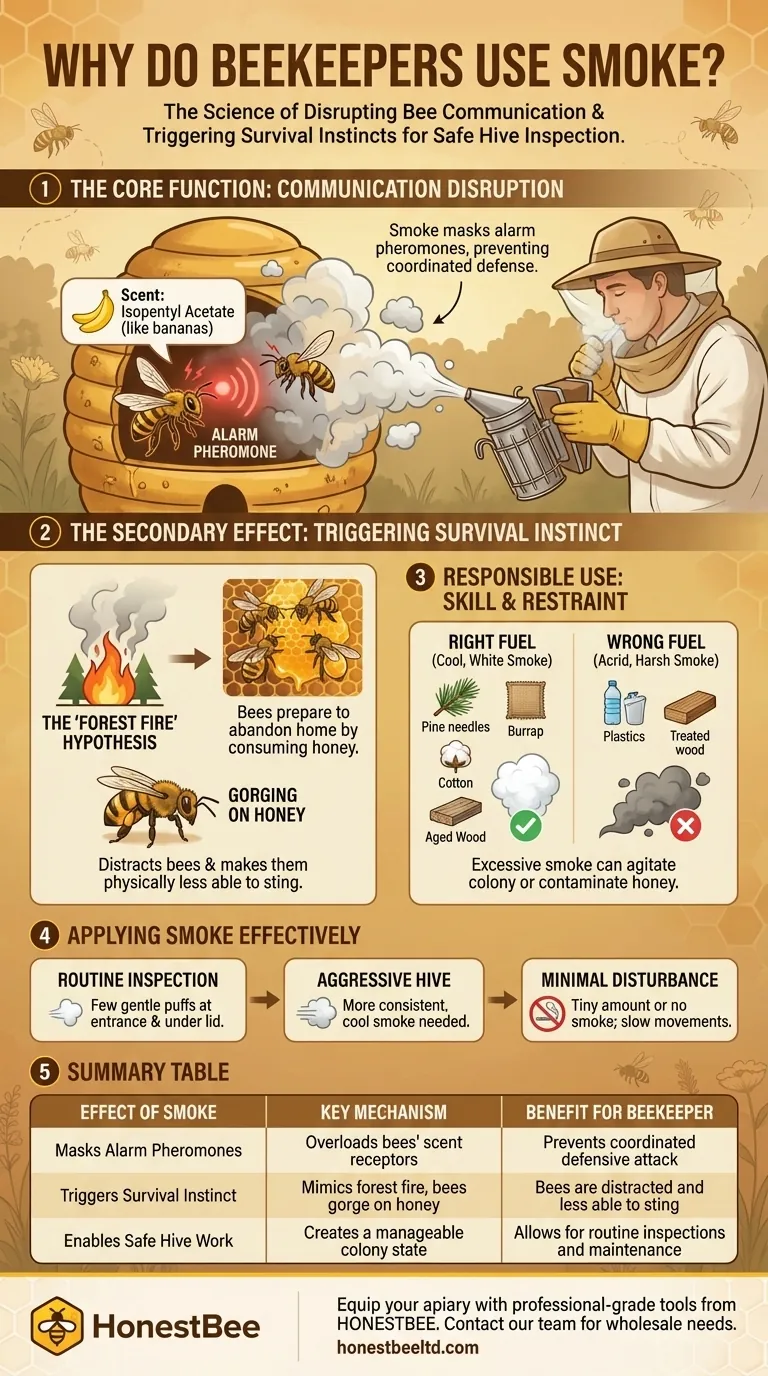To put it simply, beekeepers use smoke to disrupt the bees' primary mode of communication: scent. A few gentle puffs of smoke mask the alarm pheromones that guard bees release when they perceive a threat, preventing a coordinated defense response from the rest of the colony. This allows the beekeeper to inspect the hive safely and with minimal stress to the bees.
The core function of smoke is not to "calm" the bees in an emotional sense, but to chemically interrupt their ability to communicate danger, while also triggering a natural survival instinct that distracts them from the beekeeper's presence.
The Primary Role of Smoke: Communication Disruption
A honeybee colony operates as a superorganism, relying on chemical signals called pheromones to communicate complex information rapidly. The beekeeper's smoke directly interferes with this vital communication channel.
What Are Alarm Pheromones?
When a guard bee feels threatened, it releases a specific alarm pheromone. This chemical signal instantly alerts other bees in the vicinity to the potential danger, recruiting them to defend the hive.
The primary component of this pheromone is isopentyl acetate, which smells distinctly like bananas to the human nose.
How Smoke Masks the Signal
Smoke is a complex aerosol containing thousands of fine particles and chemical compounds. When introduced into the hive, these particles overwhelm the sensitive receptors on the bees' antennae.
This sensory overload makes it impossible for the bees to detect the alarm pheromone. Without the signal, a large-scale defensive response is never initiated, and the hive remains in a more manageable state.
The Secondary Effect: Triggering a Survival Instinct
Beyond simply blocking communication, smoke also triggers a far more ancient and powerful instinct related to self-preservation.
The 'Forest Fire' Hypothesis
For millions of years, the smell of smoke has signaled one thing to bees: a forest fire. When bees sense a fire, their immediate priority is not to fight, but to prepare for the potential need to abandon their home.
Gorging on Honey and its Calming Effect
The bees' emergency plan is to consume as much honey as they can hold. This ensures they have the energy reserves needed to fly a long distance and build a new hive if necessary.
A bee with a full abdomen of honey is physically less able to flex its body to sting. Furthermore, its attention is diverted from the intruder (the beekeeper) to the more pressing task of consuming food for survival.
Understanding the Trade-offs and Responsible Use
While smoke is an essential tool, its application requires skill and restraint. It is not a magical calming agent, and improper use can cause more harm than good.
The Danger of Too Much Smoke
Excessive or hot smoke can have the opposite of the intended effect. It can agitate the colony, cause unnecessary stress, and even drive the bees to abscond (abandon the hive).
Over-smoking can also contaminate the honey and wax with a smoky flavor, reducing the quality of the harvest.
Using the Right Fuel
The goal is to produce cool, white smoke. Beekeepers achieve this by using natural, untreated fuels like pine needles, burlap, cotton, or aged wood shavings.
Using materials that produce acrid, harsh smoke, such as plastics or treated wood, is harmful to the bees and the beekeeper.
Applying Smoke Effectively for Your Goal
The amount and timing of smoke application depend entirely on the beekeeper's objective and the temperament of the colony.
- If your primary focus is a quick, routine inspection: A few gentle puffs at the entrance and under the lid are often sufficient to mask initial alarm signals.
- If you are dealing with a known aggressive hive: More consistent, cool smoke may be needed to keep the communication channels blocked throughout the inspection.
- If your goal is minimal disturbance (e.g., adding a feeder): You might use only a tiny amount of smoke or none at all, relying on slow, deliberate movements.
Ultimately, mastering the use of smoke is about learning to read the bees' behavior and providing just enough to accomplish your task efficiently and peacefully.
Summary Table:
| Effect of Smoke | Key Mechanism | Benefit for Beekeeper |
|---|---|---|
| Masks Alarm Pheromones | Overloads bees' scent receptors | Prevents coordinated defensive attack |
| Triggers Survival Instinct | Mimics forest fire, bees gorge on honey | Bees are distracted and less able to sting |
| Enables Safe Hive Work | Creates a manageable colony state | Allows for routine inspections and maintenance |
Equip your apiary with professional-grade tools from HONESTBEE. As a trusted wholesale supplier for commercial apiaries and beekeeping equipment distributors, we provide the reliable equipment you need for effective and responsible hive management. Contact our team today to discuss your wholesale needs and discover how our supplies can support your beekeeping success.
Visual Guide

Related Products
- Stainless Steel Honey Bee Smoker Hive and Honeycomb Smoker for Beekeeping
- Economy Galvanized Beekeeping Honey Bee Smoker for Wholesale
- Stainless Steel Bee Hive Smoker Beekeeping Smoker for Wholesale
- Premium Traditional Copper Bee Smoker with Bellows
- European Stainless Steel Bee Smoker for Honey Bee Hive
People Also Ask
- What is the primary purpose of using smoke in beekeeping? Calm Bees for Safer Hive Management
- What is a bee smoker and how does it work? Master the Tool for Calm, Safe Hive Inspections
- How long does it take to clean a bee smoker? From 15-Minute Quick Fix to 10-Hour Deep Clean
- What is a Smoker and how is it used in beekeeping? The Essential Tool for Calm, Safe Hive Inspections
- What is a bee smoker and what is its primary purpose? Master Safe Hive Inspections



















